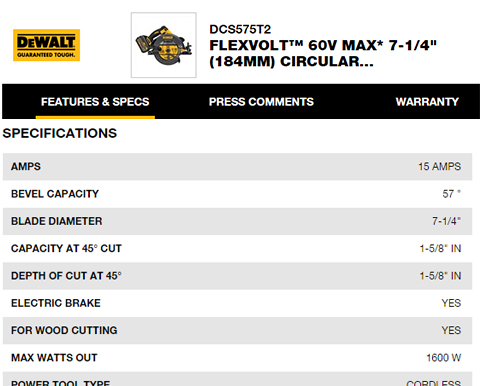In recent years there have been a lot of advancements that allow tools to work effectively at various voltages as well as batteries with dramatically higher Amp Hours (Ah). Unfortunately that’s all the tool brands want to talk about in terms of specs on these awesome tool achievements, Volts and Ah but clearly that does not tell the full story. The formula Amps * Volts = Watts is what we use to figure out power and works great with corded tools on our meter above. With battery tools if you are only provided Volts and Ah ratings (or Watt Hour Wh) unfortunately you’re never going to be able to determine the real power of your tools.
Amp is not the Same as Amp Hour
Ah is a rating to measure the battery capacity or “the gas tank” a Chevy Spark and Corvette might have the same size gas tank but speed is going to be a little different. When we look at two very similar tools where we do get a “power measurement” Milwaukee M18 FUEL SDS-Plus hammers give a power rating in ft-lbs, common for all rotary hammer drills, the 2712-22 has 1.7 ft-lbs the 2715-22 has 3.3 ft-lbs, both are using brushless motor technology with 18 Volts and 5.0Ah batteries but clearly there are producing different amounts of watts & amps. When looking at corded tools the same manufacturer will offer an 8 amp, 10 amp and 12 amp versions of their 5” grinders that all use the same 110 outlet everyone knows which is more powerful and relatively by how much. Amps don’t tell the full story, especially not when comparing different brands but is a useful spec to have.
Peak Watts Output
In Bosch’s new battery campaign for the CORE18V (available now) they talk about how their new 6.3 Ah battery is 43% more powerful than competition (Dewalt FlexVolt 6.0 & M18 9.0) and 80% more power out than their battery, going from 6.0Ah to 6.3Ah. This rating is a per “Cell” rating which is basically the difference of going from 18650 to 20700 cells. Jumping to the new cells also provides the ability for Bosch to jump from 800 peak watt output of the battery to a very impressive 1440 peak watt output. Now we are getting somewhere, we can compare watts pretty easily, 800 watts would be roughly an entry level 4.5” corded grinder (around 7.5 amp) but 1400 watt would be a very powerful 6” grinder (around 12 Amps) that’s a big difference in potential tools it can power.
Measuring in Watts would allow better comparisons between models, different voltage, and different brands but also in comparisons to corded tools. This issue however is there is no standard for measuring watts all the brands can agree so it’ll be like max vs nominal voltage or torque vs nut busting torque.
It looks like Dewalt is the first to start rating their tools and provide “Max Watts Out” on a couple of the new FlexVolt, an impressive 1600 Max Watt Out for the circular saw we tested in our recent cordless circular saw shootout. Although they also rate the saw at 15 Amp which if plug these 3 numbers into the formula Amp (15) x Volts (60) = Watts (1600) the math doesn’t add up correctly. Stupid math, they take all the fun out of marketing!!! We hate to call out the yellow team here because we really really really do appreciate taking the next step and giving everyone some sort of power rating in watts. Even if there is a little marketing fluff with “max” voltage, “max” watts and amp ratings they got from??
Can New Batteries Make Your Existing Tools More Powerful?
Yes the can, in the Metabo video above it’s a great example how their LiHD batteries (use the 20700 cells) actually provides more power to the same cordless tool. Metabo shared a little with us about their own battery gains going to LiHD and their “working watt” rating (a much more conservative measure) is over 1250 watts with a “peak watt” estimated in that 1400-1500 watt range. This does represent a big jump in power, up to 67% on some tools, however it’s dependent on each tool and if the tool can utilize that higher watt output. We would expect the same results for other tool brands once they upgrade their cells.
The Secret Sauce
As all the tool companies jump to newer cells and make other leaps forward in power we do think we will start to see more brands share a peak watt number or something similar. Of course the second that becomes a measurement consumers look for and make purchased based on, some marketing genius will create a tool that has wild power surges just so they can claim 3500 peak watts (and we have no doubt it’ll sell).
The secret sauce of cordless tool systems is in efficiency and heat management. Today’s cordless tools have more computing power than the spaceship that sent men to the moon, there are chips in the batteries and tools, that optimize efficiency to gain power, extend runtime and ensure the tool will last. With all the Lithium Ion cells essentially being purchased on the open market the differences in one tool brand vs another is how effectively they can build a complete system; motor, electronics, gearing, housing, battery pack to most effectively power the tool off those mass produced cells.
Unfortunately there is no quick and dirty answer for comparing power between cordless tools and it doesn’t look like the cordless tool companies are going to come together to create a universal standard anytime soon.






